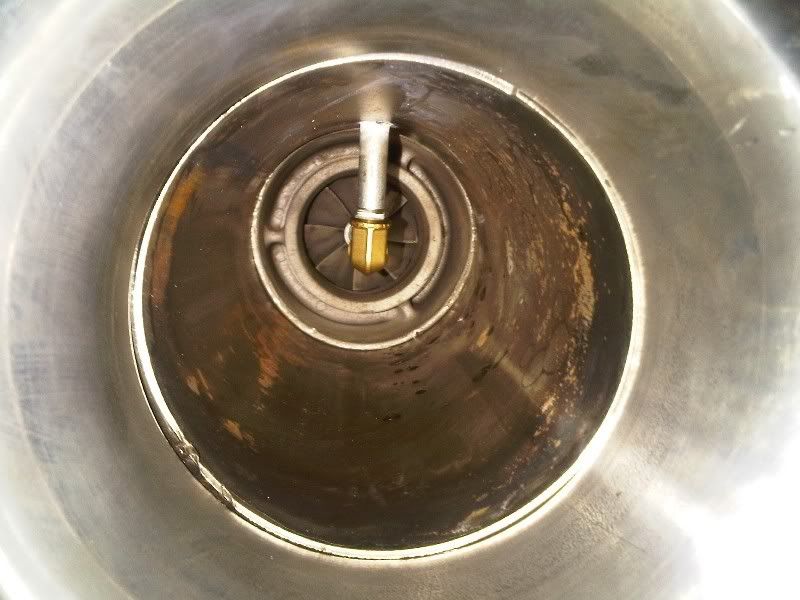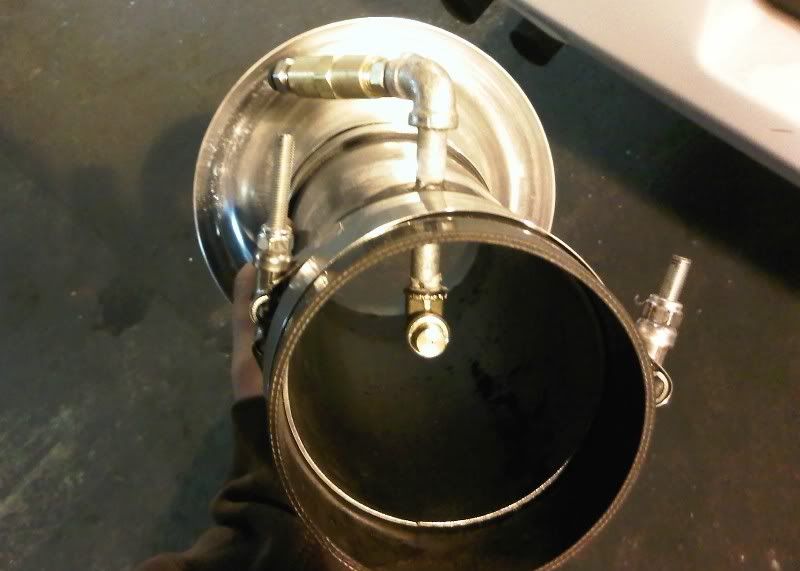
 |
|
#391
|
|||
|
|||
|
Quote:
I've ran 10 and 14 gph nozzles before my turbo with no problems. These are huge nozzles! Rodney |
|
#392
|
|||
|
|||
|
Hallo,
i've tried to read the last 27 pages more or less but i'am curious about if there was something like a conclusion about this discussion? open questions would be: - is there a difference between pre-compressor and post-intercooler injection? - is there a difference (i guess it is) in in-cylinder cooling effects on the injection position? - would it be maybe a benefit to use both types of injections to improve turbo efficiency and have a in-cylinder-cooling effect? |
|
#393
|
|||
|
|||
|
Quote:
But in cylinder effect (end gas pressure and temperature) will not vary a lot regardless of where you are injecting the fluid for the simple reason that its the conversion from liquid to gas that had the highest heat conversion rate. In my tests over the years I have always found a net vehicle increase in speed (over numerous test conditions) with pre turbo V's any post turbo inj location. *all of the other locations don't yield a performance increase when other variables are held constant* and lastly I am sure if you have a very advanced system like made here you can use multiple points of injection and get the best theoretical performance from this. This is but one response and view though 
__________________
http://www.riceracing.com.au RICESP > F40 > Zonda > ZR1 Water Injection Specialist "Can't be defeated!, don't know the word!, shoulder to shoulder!, we'll fight the world!, WE CAN'T BE BEATEN!!!" |
|
#394
|
|||
|
|||
|
I have often been asked about compressors wheel wear, is this is myth or probable? You are the one of the long term users of pre-turbo users. However I like to point out that you use a more superior technology by using air-assisted nozzle with super-fine droplets.
Please post some of your experiences on this myth.
__________________
Richard L aquamist technical support |
|
#395
|
|||
|
|||
|
Quote:
I had one customer/friend who bought a USB bore scope camera and took a video to show the water going into the front of the turbo (in his case he had noticeable wheel wear with my system), it seems to be related on where exactly the unit is placed and also if the compressor housing has a bell mouth like found on GT Garrett turbo's (GT35R and TO4Z for example). I have many other people (in stated ratio) who say its just not so and you cant see any signs of wear at all on the leading edge of the compressor wheel. My personal recommendation is regardless of system (yours mine someone else) to place the water jet against the flow of air if possible or if its following the path of air or mounted on the out pipe wall to injected it a long way down stream of the compressor wheel and not to mount it on the inner radius of a pipe bend. It is more complex than what it seems and it looks like it can be done the wrong way and mark the turbo compressor. On the weekend I was at the local drag track and there is a friend of mine who runs a very old school turbo set up with suck through tripple SU carbs (in front of turbo), T04, 36psi boost, methanol fueled, and water injection, the water "jet" is nothing but a nozzel and a solid stream goes in front the middle carb! no compressor wheel wear has ever been seen on this set up *go figure*
__________________
http://www.riceracing.com.au RICESP > F40 > Zonda > ZR1 Water Injection Specialist "Can't be defeated!, don't know the word!, shoulder to shoulder!, we'll fight the world!, WE CAN'T BE BEATEN!!!" |
|
#396
|
|||
|
|||
|
My personal feeling:
I am not concerned with a small amount of compressor wheel wear given the many benefits of running this technology. Many years ago one person I know changed his compressor wheel over from one that looked like the above picture to a brand new one and there was no measurable difference in performance of the car on the dyno or the track...... he wasted $1300 on the rebuild, but I can understand why he did it. After I go though at least 50lt of injection fluid I will post up my own comp wheel picture irrespective of what it may look like :lol:
__________________
http://www.riceracing.com.au RICESP > F40 > Zonda > ZR1 Water Injection Specialist "Can't be defeated!, don't know the word!, shoulder to shoulder!, we'll fight the world!, WE CAN'T BE BEATEN!!!" |
|
#397
|
|||
|
|||
|
I don't think your system wouldn't do any damages to the wheel, the droplet is so amazingly fine. I do recommend your system to many people. I also don't think a pitted wheel makes too much difference to the flow, compared to a new wheel. The cooling effect far out weighs the cost of the wheel.
__________________
Richard L aquamist technical support |
|
#398
|
|||
|
|||
|
Quote:
So all the talk of injecting water straight into the nut of the turbo is not the ideal setup in your opinion? Wouldn't spraying the water towards the filter cause saturatuion of the air filter and excessive puddling on the inside of the pipe? all video and testing provided by 99gst_racer on dsmtuners.com Like so...   Here is a video of the setup in action. http://www.youtube.com/watch?v=F51xymg33-w And here's a video of one of the pulls: YouTube - Engine Dyno Pull @ Street & Strip TEST RESULTS Set-up specifics: The engine on the dyno was a relatively stock 2.3L Ford engine out of a late 80's Thunderbird. The turbo was a Holset HX-35 running at 22-23 psi. The engine was producing roughly 450HP and 389 ft/lb torque. The nozzles were all mounted in the same location throughout the tests - about 4" away from the compressor nut. The pump used was the Devil's Own 250 psi pump. Here are the results that we gathered: No injection; Before IC temp increase - 29 deg/sec After IC temp increase - 4 deg/sec Peak boost 22.09 PSI ------------------------------------------------------ 1GPH 50/50 mix; Before IC temp increase - 19.1 deg/sec After IC temp increase - 3.0 deg/sec Peak boost 22.88 PSI 1GPH H20; Before ic temp increase - 24.2 deg/sec After IC temp increase - 3.4 deg/sec Peak boost 23.21 PSI 1GPH Washer Solvent; Before IC temp increase - 24 deg/sec After IC temp increase - 3 deg/sec Peak boost 22.96 PSI --------------------------------------------------- 7GPH 50/50 mix; Before IC temp increase - 16.9 deg/sec After IC temp increase - 4.5 deg/sec Peak boost 22.96 PSI 7GPH Water; Before IC temp increase - 13 deg/sec After IC temp increase - 4.7 deg/sec <---no IC fan - OOPS! Peak boost 22.92 PSI 7GPH Methanol; Before IC temp increase - 19.3 deg/sec After IC temp increase - 3.5 deg/sec Peak boost 23.0 PSI 7GPH Washer Solvent; Before IC temp increase - 11 deg/sec After IC temp increase - 3.8 deg/sec Peak boost 23.3 PSI ----------------------------------------------------------- 10GPH Methanol; Before IC temp increase - 14.3 deg/sec After IC temp increase - 3.2 deg/sec Peak boost 23.05 PSI 10GPH Washer Solvent Before IC temp increase - 11.2 deg/sec After IC temp increase - 3.4 deg/sec Peak boost 22.71 PSI |
|
#399
|
|||
|
|||
|
ff86, I have video with pressure transducers mounted in air and water feed through telemetry showing target droplet size happening at 7psi, I generally tell customers to switch it on at about 10psi+ and some drag C16 users operating at 36psi boost pressure tend to turn on the system at 20 to 22psi level.
Got a few users who inject into the end cap of the air filter and they don't report water loading of the element, probably to do with air flow rates, seems to be not an issue, but I am sure if you did just one pull and shut off everything off from an open throttle then you would see some evidence of water there. So far as ideal spray position? my feeling is to inject into a chamber, this is what I tried to create on my own car, this so far seems to work best.
__________________
http://www.riceracing.com.au RICESP > F40 > Zonda > ZR1 Water Injection Specialist "Can't be defeated!, don't know the word!, shoulder to shoulder!, we'll fight the world!, WE CAN'T BE BEATEN!!!" |
|
#400
|
|||
|
|||
|
Quote:
Thanks! |
 |
|
|